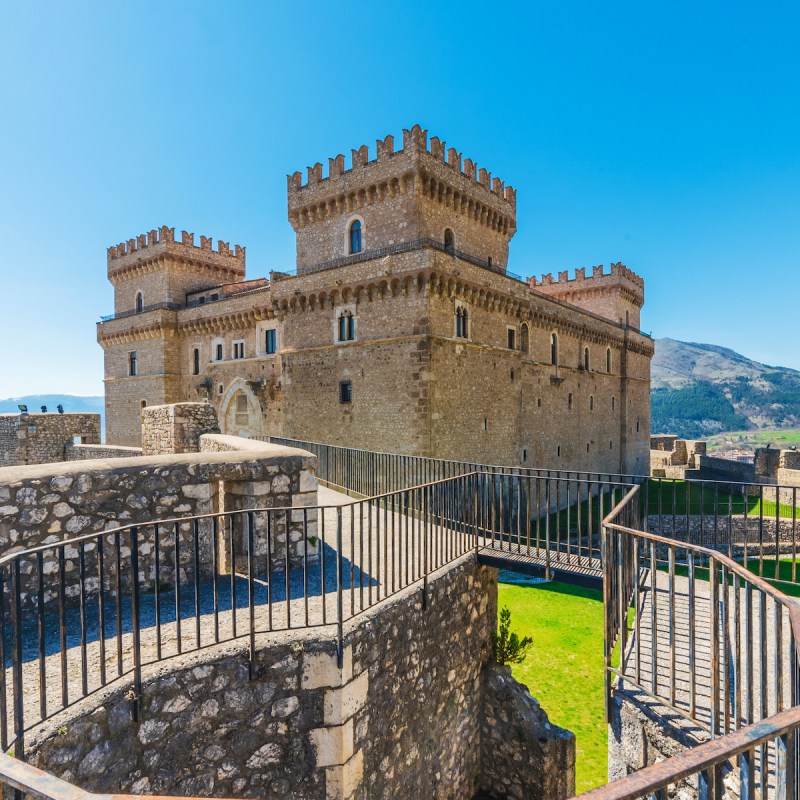
Stopping by a castle or palace on holiday in Italy is a great way to learn about the history of the region and the country, and it will often come hand in hand with some eye-popping views. Join me on a tour of some of Italy’s most spectacular castles, fortresses, and palaces, from the imposing mountaintop Rocca Calascio, the highest fortress in the Apennines, to the little-known Castello della Manta in the Piedmont region.
Videos by TravelAwaits

1. Rocca Calascio
Calascio, Province Of L’Aquila, Abruzzo
Castles and fortresses are a common sight in Abruzzo, a stunning region that remains firmly off the tourist trail, set to the east of Rome. It is a beautiful region to hike in, not least for the extraordinary number of medieval castles and impressive fortresses immersed in the greenery of the national parks and nature reserves.
Rocca Calascio is possibly the best-known and most striking of the region’s forts. If you think it looks familiar, it may be that you recognize it from the film The Name of the Rose. Initially built as a watchtower, the 13th-century fort is perched on rocky cliffs at a height of 1460 meters, making it one of the oldest standing forts in Italy. It was developed further in the 14th century, and again in the 16th century by the Medici family, but suffered considerable damage in an earthquake in 1703. To get there, park in the village of Calascio, where you will find several bars and restaurants, and follow the winding path to the castle (around 3.5 kilometers each way).
Pro Tip: After your walk, visit the neighboring town of Santo Stefano in Sessanio, a restored medieval village, and one of the most popular stops on our Wilds of Abruzzo tour.
2. Castello Piccolomini
Celano, Province Of L’Aquila, Abruzzo
Still in the Abruzzo, the enormous Piccolomini Castle sits in the historic center of the hilltop town of Celano, dwarfing the town below and set against the gorgeous backdrop of Monte Sirente. The location is perhaps less picturesque than Rocca Calascio but the imposing structure of the castle merits a visit in its own right. Built in the late 14th century, the vast rectangular castle is surrounded by massive walls, with large square towers at each corner, and is currently home to the Marsica Museum.
Pro Tip: Time to spare? Drive to the pretty town of Sulmona where colorful displays of sugared almonds (“confetti” in Italian) fill shop windows. Confetti production in the town began back in the 15th century.

3. Castello Malaspina
Massa, Province Of Massa And Carrara, Tuscany
Continue northwest to Tuscany where numerous castles and palaces are tucked away amid the familiar landscape of rolling hills intersected by lines of cypress trees. Many of the castles, originally built for protection, are an excellent way to delve deep into the region’s history and traditions.
Sitting on the border of Tuscany and Liguria, and one of the highlights of our tour to the area, Castello Malaspina di Fosdinovo is generally regarded as Italy’s largest and best-preserved castle. Built in 1340, the castle comes complete with crenelated round towers, and hanging gardens. Inside there are collections of art, ceramics, weapons, and — just what every good castle needs — a torture room! The castle is still owned today by the Malaspina family.
Pro Tip: Check opening times during the winter months on the Comune di Massa website.
4. Castello Monteriggioni
Monteriggioni, Province Of Siena, Tuscany
Built by the Sienese in the early 13th century in a strategic hilltop location just 20 kilometers from Siena, Monteriggioni Castle is more of a walled medieval town than a standalone castle, although it did start as a castle. Today, the 14 towers and two gates on the fortified wall remain intact and the towers can be spotted from miles away.
If you happen to be in the area in early July, it is worth stopping by for a glimpse of the town’s spectacular medieval festival, complete with craftsmen and others in full period costume, and entertainment in the form of music, live performances, duels, and acrobats. You can get more information on the festival here.
Pro Tip: Park in the main car park at the bottom of the hill in Monteriggioni, just after leaving the main road.

5. Rocca Manfrediana
Brisighella, Province Of Ravenna, Emilia-Romagna
If you are looking for a classic medieval castle, look no further than Rocca Manfrediana near Ravenna in the Emilia-Romagna region. The village of Brisighella is surrounded by three spurs, on top of which stand the castle (La Rocca), a charming clock tower, and the Monticino Sanctuary. Built in 1310 by the Manfredi family, the castle was ruled for a few years in the early 16th century by the Republic of Venice, eventually ending up under the control of the Vatican states.
Leave time to explore Brisighella’s colorful streets and tiny squares, fringed by pastel-hued houses. Also, check out the extraordinary “Donkeys’ Alley” (Via degli Asini), originally a military outlook and latterly used, and lived in, by those transporting gypsum from the nearby caves on their donkeys.
Pro Tip: Olives have been cultivated locally since ancient times. Be sure to stock up on some of the town’s award-winning olive oil which has a distinctive spicy flavor.
6. Reggia Di Caserta
Caserta, Province Of Caserta, Campania
Get ready for grandeur on a whole different scale at the Caserta Royal Palace and Park. Situated to the north of Naples, the 18th-century palace was designed by the great Luigi Vanvitelli, under the instructions of the Bourbon king Charles III, to rival Versailles and the Palace in Madrid. Reputedly the largest palace in the world, the scale of the palace and garden is simply awesome. Exteriors include four courtyards, parkland, fountains, a waterfall, and gardens including the English Garden, which is recognized as one of the greatest of Europe’s gardens.
The interiors are no less impressive, boasting an extraordinary 1200 rooms, including royal rooms, the Court Chapel, and a theater modeled on the Teatro San Carlo in Naples.
Pro Tip: Allow plenty of time! You can easily spend a day here if you want to visit the palace and park without rushing.
7. Castello Reale di Racconigi
Racconigi, Province Of Cuneo, Piedmont
Visiting a selection of castles and palaces in Piedmont is another giant history lesson. Before Italy’s unification in the 19th century, when it was ruled by numerous small principalities, Piedmont was the historical home of the Savoy family who left their mark in the form of turreted castles and glitzy palaces.
The extraordinary UNESCO World Heritage Royal Castle of Racconigi, a palace and 170-hectare park in the province of Cuneo, near Turin, was the summer residence of the Carignano line of the House of Savoy. The French influence is evident, most notably in the landscaped gardens. The gardens were designed in the 17th century by the Parisian André Le Notre who also designed the gardens of the Palace of Versailles. Other highlights include the Salone d’Ercole, the Gallery of Portraits, and the Chinese apartments.
Pro Tip: There are no independent visits — all castle tours are guided.

8. Castello Della Manta
Manta, Province Of Cuneo, Piedmont
The Castello della Manta near the charming town of Saluzzo in Piedmont is rather more off the radar but a superb illustration of the power and wealth of the Saluzzo della Manta family.
The extraordinary 12th-century castle was enlarged and transformed in the 15th century into a lavish family home by Valerano, the ruler of the Marquisate of Saluzzo. With a backdrop of the Cottian Alps and spectacular Monviso massif, the castle is probably best known for its magnificent cycle of late Gothic frescoes in the Baronial Hall. Leave time to also visit the cellars and huge kitchen with its vaulted ceiling and vast fireplace.
Pro Tip: Stay in nearby Saluzzo, one of Piedmont’s most atmospheric towns, with churches, castles, and historic arcaded streets.
For more information on traveling to Italy, check out these articles:
